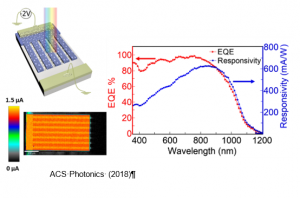The Chair of Electronic Devices at RWTH Aachen University and AMO GmbH in collaboration with the University of Granada has experimentally demonstrated graphene/silicon (G/Si) photodiodes that reach nearly 100% quantum efficiency. The work was recently published in ACS Photonics and has been selected as ACS Editor’s Choice article, highlighting the importance of the research work. The work will also appear on a cover page of Journal.
 Improving the performance of graphene/silicon photodetectors in terms of efficiency and responsivity, has been a bottleneck for their applications. After understanding the fundamental contribution towards photocurrent in in graphene/silicon photodiodes, they have been able to demonstrate a specific device design that enhances the performance of graphene/silicon photodiodes over a broad range of wavelengths. In the proposed design, they have employed an interdigitated contact pattern scheme of graphene /silicon Schottky diodes with graphene/silicon dioxide / silicon regions where chemical vapor depositioned graphene acts as a transparent conductive electrode. The devices are fabricated with standard silicon technology, and the concept can in principle be scaled to large-volume production.
Improving the performance of graphene/silicon photodetectors in terms of efficiency and responsivity, has been a bottleneck for their applications. After understanding the fundamental contribution towards photocurrent in in graphene/silicon photodiodes, they have been able to demonstrate a specific device design that enhances the performance of graphene/silicon photodiodes over a broad range of wavelengths. In the proposed design, they have employed an interdigitated contact pattern scheme of graphene /silicon Schottky diodes with graphene/silicon dioxide / silicon regions where chemical vapor depositioned graphene acts as a transparent conductive electrode. The devices are fabricated with standard silicon technology, and the concept can in principle be scaled to large-volume production.
The research work was funded by German Research Foundation (DFG GRK 1564), the European Commission through the project Graphene Flagship (785219), the Spanish Ministry of Education, Culture and Sport (MECD) and the University of Granada through the project TEC2017-89955-P and the predoctoral grant FPU014/02579.
